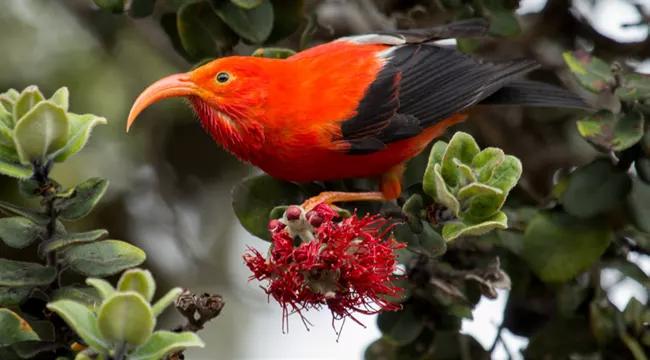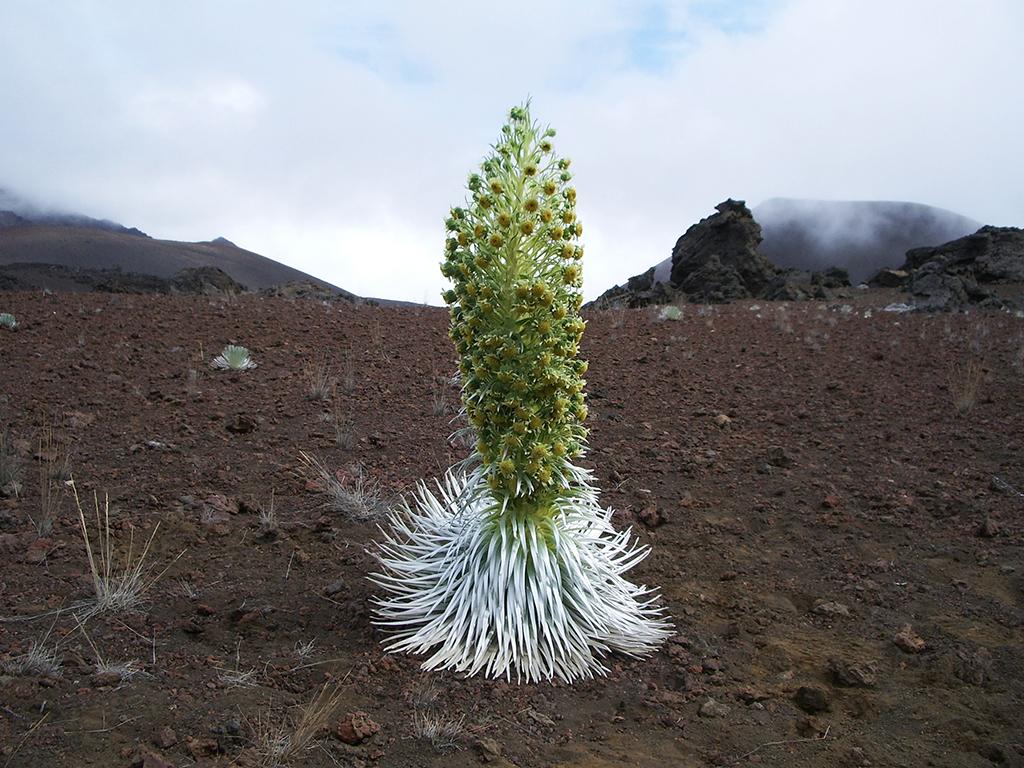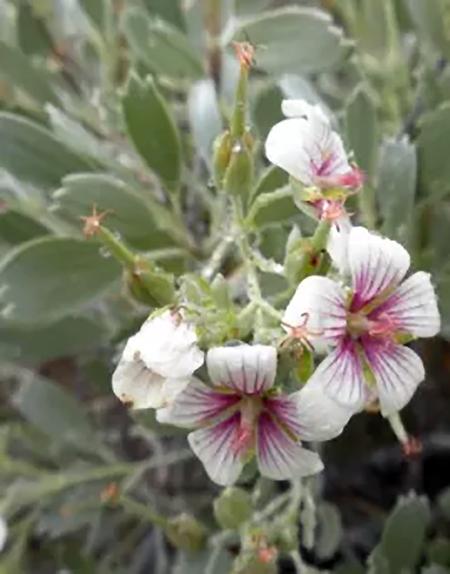Haleakalā National Park on Maui, Hawaii, is home to an amazing variety of native plant and animal species, many of which are endemic (found only in one area and nowhere else in the world). This national park also harbors more endangered species than any other national park in the United States and has its fair share of invasive plant and animal species, as well.

A brightly-colored ‘I‘iwi, Haleakalā National Park / Mark Kimora via NPS
Hawaiian Honeycreepers
- ‘Apapane (Himatione sanguinea)
- ‘I‘iwi (Drepanis coccinea)
- Hawai‘i ‘Amakihi (Chlorodrepanis virens)
- ‘Alauahio (Paroreomyza montana)
- Kiwikiu (Maui Parrotbill) (Pseudonestor xanthophrys)
- Ākohekohe (Palmeria dolei)
Hike into the forests of this national park and you may see a colorful feathered “jewel” flitting from branch to branch. Hawaii once had more than 50 species of forest birds, but only 17 species remain today, some with fewer than 500 individuals left. Of these 17 species, six species are honeycreepers, brightly-colored birds with specialized bills to feed off nectar and the insects living in flowers. Five species of honeycreepers are endemic and of the total six species, two are critically endangered and one is threatened.
Part of these birds’ decline is related to loss of habitat and natural predators (including feral cats). But the greatest threat is the invasive Culex mosquito. Climate change creates a warmer atmosphere higher in elevation, so this mosquito can find and feed on these Hawaiian birds from the lower-elevation forests on up into the mountain forests. When the mosquito grabs a meal from one of these birds, it leaves behind avian malaria.
In a 2022 Traveler article (updated in 2024) about how national parks are battling back against invasive species, Chris Warren, a forest bird biologist at Haleakalā, said "Most of Hawaii's honeycreepers, which is, and was, the most diverse group of native birds, they're immunologically naive to avian malaria, which is a really common disease throughout the world." Warren went on to say that birds in most of the rest of the world might suffer a bit from a Culex bite, then recover. With the forest birds of Hawaii, however, they get bitten by a Culex mosquito and they “drop dead.”
According to park staff:
Haleakalā National Park is working to save Maui’s forest birds. Helping the birds means controlling mosquito populations, which is trickier than it sounds. Standard control measures like traps don’t work in the remote forests where these birds live. Spraying pesticides to kill mosquitoes could harm the watersheds both birds and humans rely on for water. In the meantime, the park is controlling other threats to forest birds. By taking steps to reduce feral animals and predators, improve the native landscape, and monitor these populations, Haleakalā National Park is on the frontline of protecting the native birds of Hawaiʻi. But in order to secure a better future for the forest birds, the mosquito problem may need to be tackled with some innovative methods.
One method that shows promise is using Wolbachia. Wolbachia is a naturally occurring bacteria that already exists in approximately half of global insect species, including here in Hawaiʻi. Male mosquitoes infected with the bacteria can mate but don’t produce offspring, causing populations to crash. This technique has been used successfully on islands around the world as well as in China and other places throughout the United States. Here on Maui and in Haleakalā National Park, fewer mosquitoes would mean more birds.
Plant Species
Over 850 species of plants are found within the boundary of Haleakalā National Park. Of these, over 400 species are native, or arrived without human intervention; and more than 300 plant species are endemic to Hawaii.

Haleakalā silversword ('ahinahina), Haleakalā National Park / NPS file
Probably the most iconic plant is the Haleakalā silversword ('ahinahina). This endemic and rare plant is listed as vulnerable, meaning the population is increasing, but it hasn’t been without a fight.
According to park staff:
The silvery hairs, fleshy leaves, and low-growing rosette form of the Haleakalā silversword (Argyroxiphium sandwicense subsp. macrocephalum) allow it to survive in hot, dry climates like the aeolian desert cinder slopes of the crater. Silverswords live between 3 and 90 years or more. They flower once, sending up a spectacular flowering stalk, and then die soon afterward, scattering drying seeds to the wind.
Delicate silverswords ('ahinahina), once ripped up and taken home by visitors as souvenirs, now depend on management efforts for survival. Park staff fence silversword-munching ungulates out, destroy non-native plants that would crowd out silverswords, and educate park visitors to stay on trails to avoid stepping on fragile silversword seedlings and root systems.
Climate change may now present a new threat to these charismatic plants. Hotter temperatures and lower rainfall may threaten even the hardy silversword. Researchers with the University of Hawai'i are actively working with park staff to evaluate the effects of drought conditions on silverswords, and preserve these unique plants for generations to come.

The silver geranium, the most common species of geranium at Haleakalā National Park / NPS file
Haleakalā silverswords are but one of those 300 plant species endemic to Hawaii. This national park on Maui is also considered the “geranium capital of the world,” by botanists. In the Hawaiian language, these rare and unique plants are known as 'hinahina ("silver") or nohoanu ("cold-dwelling"), of which there are four endemic species:
- Geranium cuneatum subspecies tridens, or "silver geranium"
- Geranium multiflorum, or "manyflowered geranium"
- Geranium arboreum - the rarest of the four, and the only bird-pollinated geranium in the world
- Geranium hanaense.
The NPS website for Haleakala National Park has a species list you can download and save as an Excel file. This list differentiates between native and non-native species, but does not go into species endemic to Hawaii.
Wikipedia has a page dedicated to endemic fauna of Hawaii as well as another page listing Hawaiian endemic plants and animals, but which is far from complete, according to hawaiibiodiversity.org.
To read more about the plants living within this national park and the steps park staff are taking to protect the native flora, click here.
Invasive Species
The definition of invasive species, according to the National Park

Park biotech Steve Orwig removing an invasive Mexican weeping pine from the crater, Haleakalā National Park / NPS file
Service, is “a species that proliferates broadly and causes a negative impact on the surrounding environment.” In addition to the non-native Culex mosquito ravaging bird species at Haleakalā National Park and Hawaii as a whole, invasive animal threats include feral pigs, cats, rats, and mongooses. These non-native animals not only prey upon Hawaii’s native species, but also destroy those species’ habitats.
According to park staff:
For a plant to cross the vast expanse of the Pacific Ocean and reach Hawai'i, then establish and reproduce, was a significant feat. Wind, wings and waves all played a role in the establishment of native plants that arrived and survived without human help.
…New plants arrive in Hawai'i every day at 2 million times the natural rate of introduction. There are over 400 established species of non-native plants in Haleakalā National Park alone, most of which were introduced in the last century.
Invasive plants are species introduced to Hawai'i by people that pose a threat to fragile native ecosystems. Invasive plants outcompete natives by consuming water and nutrients, and growing and reproducing more quickly. They may be toxic to other plants (allelopathic), or shade them out by growing faster and taller. Many native species have lost evolutionary defenses, like plant toxins and rapid growth, that were unnecessary without predators and competitors on a brand-new island.
Some of the more prevalent invasive plants include pine trees, fireweed, and even fruit trees such as peaches. These plants may (or may not) smell nice, look pretty, or even taste good, but they all play a part in edging out the native Hawaiian plants.
You can help the park stop the threat of invasive plants by:
- Brushing off your boots to remove weed seeds before hiking in the park
- Carrying out rubbish like apple cores, peach pits, and berries, that might contain seeds
- Staying on trail to preserve fragile native plants and minimize your impact on the landscape
- Reporting unusual invasive plants to park staff
Click here to read more about invasive plants at Haleakalā National Park.





